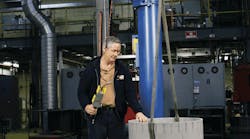In 1986, Sigourney Weaver appeared in the sci-fi film "Aliens" as Ellen Ripley – the film's heroine who saves the day by donning an exosuit and fighting off a terrorizing alien queen. What most audiences never knew was that the technology behind Weaver's battle suit actually was a beta version of what today are known as intelligent lifting devices, or ILDs.
Intelligent lifting devices provide the best of both worlds: the responsiveness and flexibility of a human operator with the power of a machine. ILDs harvest the power of a servo-controlled drive system to do the heavy lifting while the human operator guides the system's movements. The result is a seamless execution in which operators can lift and maneuver loads naturally, as if the devices were an extension of their own arms – just as Weaver did in "Aliens."
The traditional counterparts of ILDs are basic chain hoists, air balancers and manipulators – the only commercially available methods of lift assist when "Aliens" was made. While these systems satisfied the standard, up-and-down movement needs of operators, they lack the speed, precision, safety and productivity of today's ILDs.
Starting in the mid to late 1990s, companies began developing the devices that would evolve into today's intelligent lifting technology. During this process, researchers and manufacturers took into account the "100-pound paradigm" – a nugget of insight that greatly impacted the popularity of ILDs. Uncovered by sales representatives in the field, this concept revealed that laborers often will elect to manually lift a load that's 100 pounds or less rather than use a lifting device.
Why? Because, non-ILD lifting solutions can be bulky, difficult to use and ultimately slow down productivity.
ILD units can maximize productivity, because their nimbleness and ease of use minimizes the risk of injury from lifting excessively heavy loads. Because the operator has total control of lifting and precisely releasing the load, the risk for product damage is minimalized. Realizing the benefits of intelligent lifting devices, many major companies and world-class manufacturers have integrated ILDs into their workflow processes.
Benefits Are Compelling
It's easy to see why ILDs have been integrated into many workplaces; their benefits are compelling. Most ILDs are capable of lifting anywhere between 165- and 1,320-pound loads at 21 to 200 feet per minute.
This "sweet spot" makes ILDs ideal for most frequent facility lift needs. Many also offer features such as "float mode," which allows for precise, hands-free load placement, and "virtual limits," which allows operators to preset their device to move at designated speeds and stop at a chosen point. Virtual limits eliminate placement errors by preventing a load from being moved out of an operator's reach, out of ergonomic position or past the desired stop point.
ILD technology successfully has been implemented in a wide range of industries and applications.
An automobile manufacturer recently decided to add a new model into its existing assembly plant in Turkey. The designers knew that they needed to reevaluate their manufacturing processes. The cockpit installation of the automobiles is one of the most critical parts of the assembly process, and because there were now two different cockpit designs – each with different weights and dimensions – there was significant room for product or operator error.
The workers also needed to be able to switch between designs very quickly to meet their assembly target of nearly 50 cockpits per hour. The challenge demanded a solution that was capable of adapting to the constant changes in the assembly process.
Originally, the company had been using a pneumatic arm manipulator, but management ultimately decided to install a 660-pound ILD. A custom-end tooling solution was created consisting of a powered, rigid-column manipulator with a linear rail for automotive cockpit loading.
The equipment provided the workers with control and speed during the assembly process, and the solution's ease of lifting decreased the ergonomic issues that could occur in the fast-paced environment.
The workers' response to the ILD has been extremely positive.
Another company that saw "shockingly" strong results with an ILD manufactured medium-voltage switchgear, reclosers and padmount switches. The company originally was using a standard crane/hoist with a pendant to maneuver the switches, but the limited movement increased safety concerns. The process created the potential for pinch-points during the multiple lift-up/set-down transfers between workstations. The pieces were picked and placed at least three times before being installed into the cabinets and could not be transferred or easily handled without incident.
To address its issues, the company installed an ILD that provided the workers with superior control and ease of use during the assembly process, and a higher degree of safety when in "float" mode.
The various benefits of ILDs make them a smart investment for a number of reasons: The devices minimize product damage, minimize worker injury, maximize productivity and streamline workflow. ILDs can be tailored to accommodate virtually any workplace – manufacturing, assembly or possibly even alien-fighting.
Mark Grandusky is a G-Force Systems product manager with Gorbel Inc. He has more than 13 years of material handling experience and expertise.
